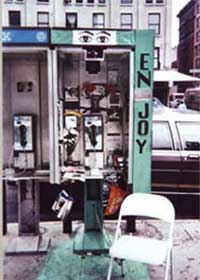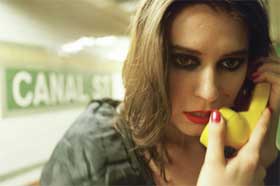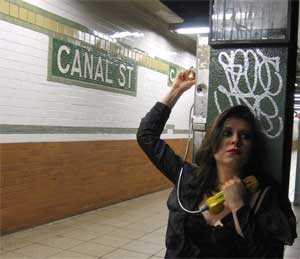 Like probably many people i wouldn't think of using a phone booth anymore but i feel a pang of nostalgia each time i see an old-style one. Many artists have created performances, installations or games around public booth. One of my favourite performances is Sophie Calle's adoption of a phone booth in Greenwich Village back in 1994.
Like probably many people i wouldn't think of using a phone booth anymore but i feel a pang of nostalgia each time i see an old-style one. Many artists have created performances, installations or games around public booth. One of my favourite performances is Sophie Calle's adoption of a phone booth in Greenwich Village back in 1994.
When Paul Auster suggested that the French artist contribute to the improvement of life in New York City, she spent a week sitting on a chair next to a public phone booth in TriBeCa. She replaced the Nynex logos with Have a Nice Day and Enjoy, stocked the booth with snacks, cigs, drinks and flowers, listened to conversations, chatted with people and got comments on the notepad left at the booth.
In the end representatives of the telephone company threw all of Calle�s improvements into a trash basket (via).
More recently, Ryan Holsopple launched a public pay phone who-dunnit that invites people to make a toll-free call from any public pay phone in Canal Street Station and solve a murder mystery.
Set in the maze of tiles that make up the station, the Canal Street Station game puts participants in the shoes of a private investigator, as he searches the depths of Canal Street Station for a young French woman that may have committed a murder, or may be a figment of his own imagination.
The game uses a Trixbox server, a phone application platform based on Asterisk�, to collect caller ID from payphones in the Canal Street Subway, and pinpoint where the player is located.
Players are asked one simple riddle that can be solved by refrencing a subway map on the platform, the answer has to be entered into the keypad when they hear Niki (alias Tajna Tanovic) say the words, "Canal Street Station."
"If you answer the clue correctly you hear her say, "Great Work Detective!" Niki then tells you a more difficult riddle that takes you to another platform in the station. The riddles become increasingly difficult as you walk the creepy corridors of the Canal Street Subway station finding the answers," explains Ryan Holsopple. "You can start on any payphone, but no matter where you begin you will eventually end up on the same platform in the end of the mystery, when you answer the final question, you are told which train to exit the station on to take you to the last stage of the mystery."
It's not the first time that the artist works with payphones: one project recorded subway Buskers, busker dial up (in collaboration with John Schimmel) and Peter Stuyvesant's Ghost, a self-guided walk through the area of Peter Stuyvesant's farm utilizing pay or cellphones to access soundworks.
I asked Holsopple a few questions about his latest project:
Why payphone? Are you still using them to make phone calls? Were you interested in working with them for some nostalgia-related reason?
I love payphones and with the growing number of mobile phones, it seems that payphones are on their way out, but I feel they are still essential to the makeup of the city.
Payphones in the NYC subway are the only way to communicate with the outside world, so that puts a boundary on users in a piece such as this, which is great when it comes to a game/theater piece.
I also love the nostalgia theme and much of the work that 31 Down does is based in nostalgia and the technology of the past and how it relates to the present.
 The theater company centers around the ideas and cliches of the 'Private Investigator', so this became extremely relevant when I started working with Asterisk, which is an open source PBX created by Mark Spencer. Asterisk (and the voyeuristic possibilities that it offers) has a very 'seedy' side to it and seems to me to be the perfect fit for a private investigator obsessed with surveillance and eavesdropping.
The theater company centers around the ideas and cliches of the 'Private Investigator', so this became extremely relevant when I started working with Asterisk, which is an open source PBX created by Mark Spencer. Asterisk (and the voyeuristic possibilities that it offers) has a very 'seedy' side to it and seems to me to be the perfect fit for a private investigator obsessed with surveillance and eavesdropping.
I was also interested in a report by the Straphangers about the state of payphones in the NYC subway.
When i first read about your project i immediately thought about some old films noir. Are there movie scenes that influenced the scenario or any other elements of your project?
31 Down's work is heavily influenced by film-noir. In this pay phone mystery, the audience gets to play the character of a private detective, Mike Sharpie. For clues along the mystery, you hear the inner voice of the detective through the phone handset, this convention has a direct relationship to the film-noir voiceover narrative, which I love.
You also hear the voice of a young lady who speaks with a heavy French accent (played by Tajna Tanovic), she may have killed someone in the station and she is leaving mysterious clues for the detective; this device is mostly based on the work of film director Krzysztof Kieslowski (Dekalog), and the use of obsession and voyeurism in his work.
Thanks Ryan!
The work is co-produced by free103point9 Transmission Arts and 31 Down radio theater and will be running until October 31, 2007. Photos of CSS by Christina Latimer.

